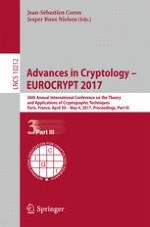2017 | OriginalPaper | Buchkapitel
Cryptanalyses of Candidate Branching Program Obfuscators
verfasst von : Yilei Chen, Craig Gentry, Shai Halevi
Erschienen in: Advances in Cryptology – EUROCRYPT 2017
Aktivieren Sie unsere intelligente Suche, um passende Fachinhalte oder Patente zu finden.
Wählen Sie Textabschnitte aus um mit Künstlicher Intelligenz passenden Patente zu finden. powered by
Markieren Sie Textabschnitte, um KI-gestützt weitere passende Inhalte zu finden. powered by
